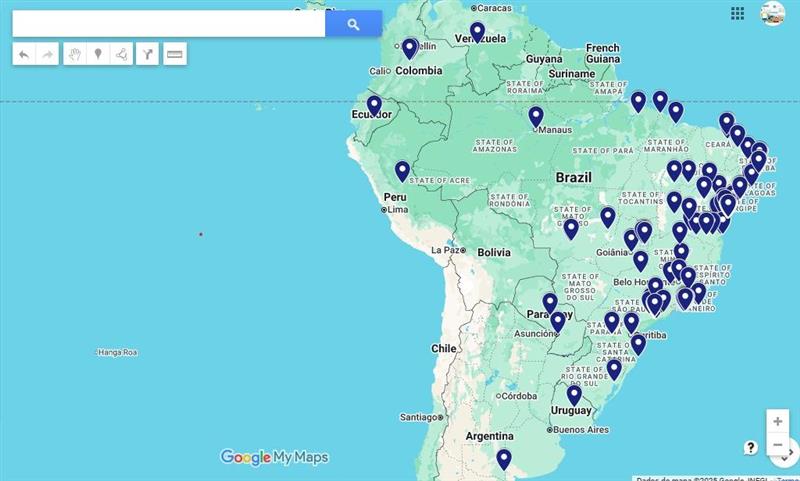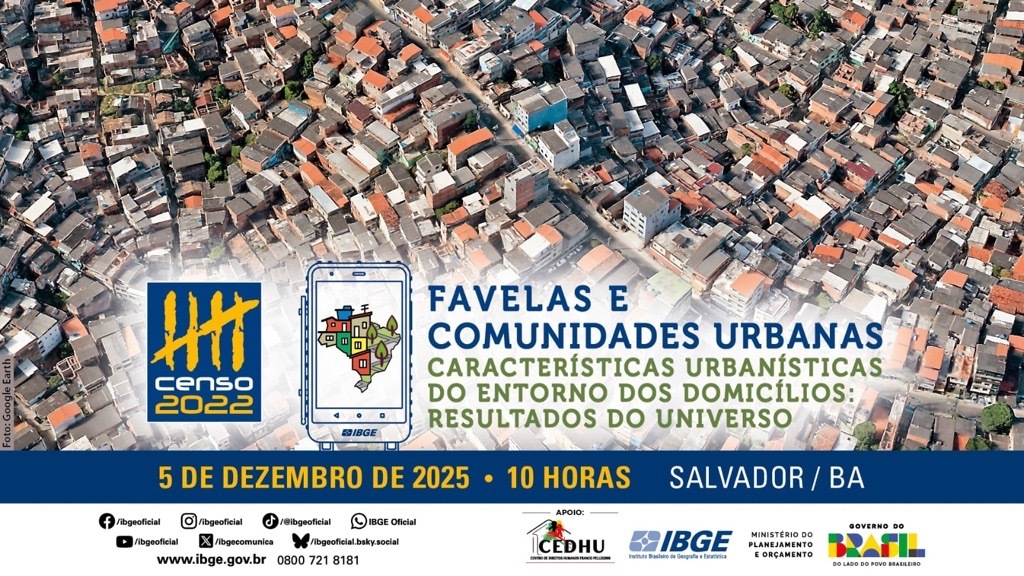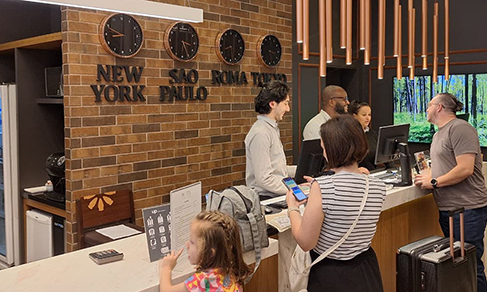2022 Census
IBGE releases sex and age information for indigenous and quilombola populations in quilombola community in Paraty (RJ)
May 03, 2024 06h00 PM | Last Updated: May 07, 2024 05h26 PM

The Brazilian Institute of Geography and Statistics (IBGE) released this Friday, 3, the results of “2022 Population Census: Quilombola and Indigenous Populations, by sex and age, according to specific geographies: Population results,” at the Campinho da Independência Quilombola Community, in the city of Paraty (RJ). More than 80 persons attended the event, which was broadcast live on Digital IBGE and on the IBGE´s social media.
The event began with the composition of the round table, which presented the data about sex and age of the indigenous and quilombola populations, by Fernando Damasco, Manager of Traditional Territories and Protected Areas, of the Coordination of Territorial Structures of the Directorate of Geosciences (DGC) and by Marta Antunes, Technician in charge of the IBGE´s Technical Project of Traditional Communities and Peoples.
Representing President Marcio Pochmann, José Francisco Lopes, IBGE´s Superintendent in Rio de Janeiro, highlighted that the “Superintendence was supported by all the groups in the municipality of Paraty. Our role is to carry out the field work to subsidize releases like this, which makes us grateful. The data produced help managers to develop public policies in the federal, state and municipal spheres,” said Lopes.
Eloá Moraes, General-Coordinator of the Ministry of Racial Equality, reminded the role of public managers in following up the data produced by the IBGE. “It is a significant accomplishment to bring the Federal Government to this territory. We have to be present in the territories to strengthen the institutions, and it is superb to receive this type of release here,” stated Moraes.

Lúcia Marina dos Santos, a State Representative in Rio de Janeiro, emphasized “the work carried out by the IBGE not only to quilombola and indigenous persons, but rather to Brazil as a whole. This is very important to access these data and recognize the first peoples of our country, now too invisible for the society. Our country should value public policies that reach the territory.”
Luciano Vidal, Paraty´s Mayor, highlighted the IBGE information and how it portrays the growth of the municipality. “We use the IBGE data to develop public policies in our city, to the caiçara people, our youth. We praise every ethnic group in Paraty, which includes the quilombola communities of our city. The IBGE unveiled that the city of Paraty grew 20%, the highest growth in the south of Rio de Janeiro. It reflects our public policies in the municipality,” said Vidal.

Marcelo da Cruz, President of Olodum, thanked the IBGE´s work of going around the country with these releases. “The IBGE does what Milton Nascimento says in his song: artists should go wherever the people are. In the entire Brazilian territory, the IBGE will talk with local social actors, public agents and the population in general to show what is is doing. One thing are the cold data, published in books, another thing is to be with us showing what is being made,” said the President of Olodum.
Iranildes Kekexu, a leader in Rio Bonito village, expressed how “rewarding is to map quilombola communities and indigenous territories. Projects and public policies are provided based on this Census, not only by the federal sphere, but also state and municipal. Indigenous persons require special education, health and structure and we are fighting to meet the law.
Daniele Elias Santos, President of the Association of Residents and Friends of the Quilombo (AMOQ), highlighted how it is “important to have these data to design public policies. We need to create the law to account for the caiçara population.”
Elizabeth Hypólito, IBGE´s Director of Surveys, mentioned that “the IBGE´s mission is to portray Brazil with information required to know its reality and to the exercise of citizenship. To accomplish this mission, we produce very important geoscientific and statistical data, like this Census, to raise not only municipal information, but also of quilombola and indigenous populations that could not be sampled. This Census innovated in the capture of indigenous populations and brought information about the quilombola population for the first time ever. It is important to assist public policies to these populations and provide visibility to these ethnic groups.

Ivone Lopes Batista, IBGE´s Director of Geosciences, highlighted “the importance of thinking on the possibilities that the 2022 Census brought in terms of the diversities of our population and territory. It is essential to know the characteristics of these different people in our country to design public policies for each one of them, like children, elderly persons and women.”

Gustavo Junger, Coordinator of the 2022 Census, highlighted the results of the Census and the work accomplished. This is the first release of the quilombola population and the second one for the indigenous population. “Information on traditional peoples like the quilombola and indigenous populations has been demanded for decades. Data on the indigenous population might be compared with the 2010 data, the first Census that included them, whereas this is the first edition of data on the quilombola population. We released today information for sex and age, but later releases will include other information,” highlighted Junger.

Marcela Cananeia, the leader of the Caiçara People in Praia do Sono, highlighted that the “traditional communities and peoples have a policy that gives rights to distinctive public policies. These data strengthen the traditional peoples, not only the caiçara people, but all the 28 peoples to show our needs. We have a daily fight that might not be only within the indigenous territories, but inside the territory as well. The IBGE is key to show how many we are, how we are and how we live.”
Carried out in partnership with the Ministry of Racial Equality, the release also counted with the presence of Artur Nobre Mendes, Funai´s General-Coordinator of Strategic Management, as well as other public managers, IBGE personnel and quilombo residents.
Technicians present sex and age of indigenous and quilombola populations
The technical team presented the data to the audience in the quilombola community and to those watching the remote broadcast via Digital IBGE and IBGE´s social media. Marta Antunes, IBGE´s Technician in charge of the Technical Project of Traditional Communities and Peoples, began by reminding data published in July last year, with population and separation by region. Antuns presented the data of the age pyramids, age profile, age groups and sex profile of the quilombola and indigenous populations. “The publication updates the demographic profile of this population in relation to the 2010 Census. These data are important to subsidize educational policies of the indigenous population, who have a distinctive education policy, as well as health policies, like children vaccination and assistance, which depend on age range and sex,” said Antunes.

Fernando Damasco, Manager of Traditional Territories and Protected Areas of the Coordination of Territorial Structure of the Directorate of Geosciences (DGC), presented the cartogram with the ageing index of quilombola persons by municipality, available in the Interactive Geographic Platform (PGI). As an example, Damasco showed the ageing index of the indigenous and quilombola populations in Paraty. “In the indigenous population that lives in indigenous lands, a younger age structure and a reduction in the weight of the elderly population is perceived in the indigenous population that lives in indigenous lands, both compared with the entire indigenous population and with the entire Brazilian population,” highlighted Damasco.

The technical team highlighted the low age of the quilombola population as well. Nearly half (48.4%) are aged 29 years and less, whereas 13.03% are aged 60 years and over. The profile is similar in the indigenous population, with 56.1% of the population aged 29 years and less and 10.65% aged 60 years and over.
Indigenous census analyst was present in release in Paraty (RJ)
Indigenous Tupã Mirim worked in the 2022 Census in the city of Ubatuba (SP) with the caiçara and indigenous populations. “Everyone in the village asked me what I was doing and, as an indigenous person, they were calmer, streamlining my work. They feared of prejudice and judgment,” said the census analyst.
Now attending the release in Paraty, he mentions the feeling of attending the release of what he contributed. “It is rewarding, I didn´t know of so much youngsters and few elderly persons in these communities. In the past, older persons took care of younger persons and now we see the reverse,” completed Tupã Mirim.
These data come from the 2022 Population Census: Quilombola and Indigenous People, by sex and age, according to specific geographies: Population results are available on the IBGE website: www.ibge.gov.br
The broadcast of the event is completely available on the Portal on the the IBGE´s social media.

















